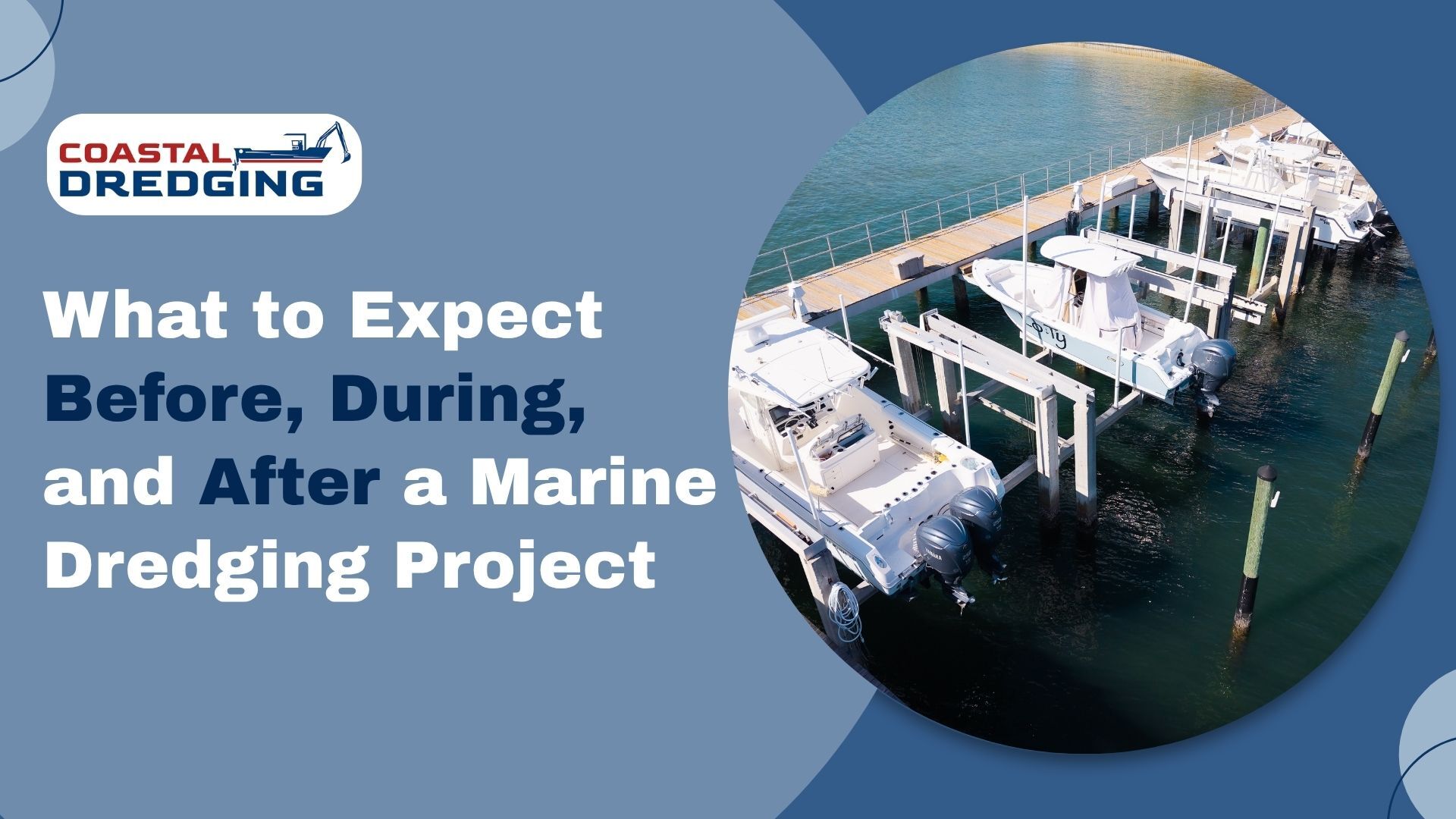
If you’ve ever looked out at your waterfront property and thought, “Wow, this could really use a facelift,” then marine dredging might be exactly what you need. Whether you’re a marina owner, a municipality, or a private property owner, marine dredging is the secret weapon to revitalize your shoreline, improve water flow, and enhance navigability.
At Coastal Dredging, we understand that taking on a marine dredging project might feel a bit overwhelming at first. But don’t worry, we’re here to walk you through what you can expect before, during, and after the entire process. We will keep things smooth, efficient, and hassle-free. So, let’s dive right in!
Planning is everything. Before a single scoop of sediment is removed, a considerable amount of preparation is required to ensure the marine dredging process is safe, effective, and tailored to your specific needs.
First, we start with a chat. During the consultation, our team will visit your site to assess the conditions and discuss your goals. Are you looking to deepen a channel? Clear out debris? Improve water flow? We want to hear all about it. We will assess water depth, bottom conditions, environmental sensitivities, and other factors. It’s like a first date, but for your shoreline.
Marine dredging is highly regulated, and for good reason. We’re working in sensitive ecosystems. However, don’t stress – we’ll help you navigate the permit process. We coordinate with local, state, and federal agencies to ensure everything is in compliance. Permitting can take a little time, but it’s crucial. The last thing anyone wants is a project shutdown halfway through.
Once we have the green light, we start plotting out all the logistics. What kind of equipment will be used? Where will the dredged material go? What’s the timeline? We tailor everything to your site and your needs. This phase also includes risk assessment and implementing plans to minimize any potential environmental impacts. We’re big on responsible dredging.
Here’s where the real action happens. Our team rolls in with specialized equipment, and the transformation begins.
You’ll see barges, dredgers, and support boats coming in. It might look like a mini floating city! We bring in everything needed to safely and efficiently remove sediment from the bottom of the waterway. Depending on the type of marine dredging we’re doing (mechanical, hydraulic, or environmental), the equipment may vary. But rest assured, we only use top-of-the-line gear that gets the job done right.
This is the heart of the operation. Sediment is carefully scooped or vacuumed from the waterbed. It sounds simple, but it’s a finely tuned process that takes a skilled team to execute. We monitor every step to make sure we’re not impacting water quality or nearby marine life. Our crews are trained to work cleanly and efficiently.
Once the sediment is removed, it doesn’t just disappear. It has to go somewhere. Depending on the type of material, it might be moved to another disposal site, used for land reclamation, or even recycled. We follow strict environmental protocols to make sure the disposal process is responsible and sustainable.
We know dredging can be disruptive. That’s why we prioritize keeping you informed. You’ll always know what’s happening and when. We’re committed to transparency and ensuring you’re comfortable with every step.
This is the time to enjoy the results! But there’s still a little work left to wrap things up properly.
Once the dredging is complete, we don’t just pack up and leave. We restore the site, remove equipment, and make sure the area looks even better than when we arrived. We also do post-dredging surveys to confirm the work meets the project goals. If adjustments are needed, we handle them promptly.
You’ll receive a comprehensive report detailing everything that was done, including volumes removed, final depths, environmental monitoring results, and more. This is great for your records and any regulatory follow-up. We’re proud of our work, and we want you to have all the details.
Now that your waterway is in top shape, you’ll notice the benefits right away: improved boat access, better water flow, healthier aquatic ecosystems, and a more attractive shoreline. Depending on your location and water conditions, you may want to schedule regular maintenance dredging every few years to keep things in prime condition. We’re always here when you need us.
Marine dredging is no small task. It takes experience, precision, and a strong commitment to both results and environmental responsibility. At Coastal Dredging, we bring all that and more. Our team consists of seasoned professionals who take pride in doing the job right. We’re local to Palm Beach County, Florida, and we know the waters. We treat every project as if it were our own backyard. Whether you need a small cleanup or a large-scale dredging operation, we have the tools, the team, and the know-how to make it happen.
Thinking about marine dredging? Let’s have a conversation. We’ll help you understand your options, plan your project, and walk with you every step of the way.
Give us a call or visit Coastal Dredging to learn more. We’re here to help you get the most out of your waterfront, and we’re pretty fun to work with, too. So, go ahead and take the plunge. Your shoreline will thank you.
The dredging process usually causes sediment disturbances, which may release contaminants into the water. In turn, this might cause a change in the chemical properties of the sediment, thereby reducing the water quality at both the dumping and extraction sites for some time after dredging has ended.
The dredging process includes the following stages: dislodging or loosening of the material from the bottom (excavation), removal of the loosened material to the dredge vessel, and transportation of the material to the placement area.